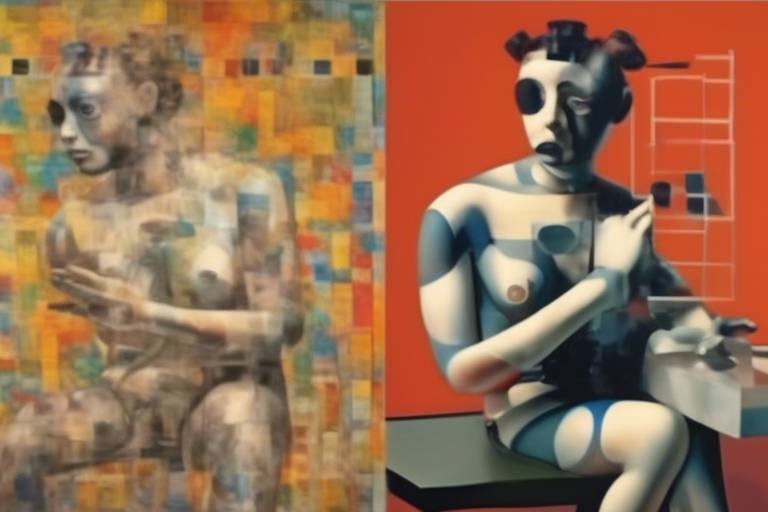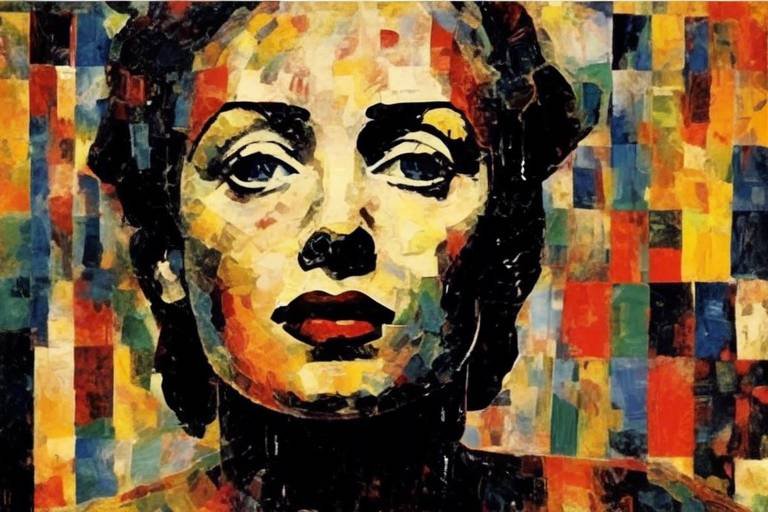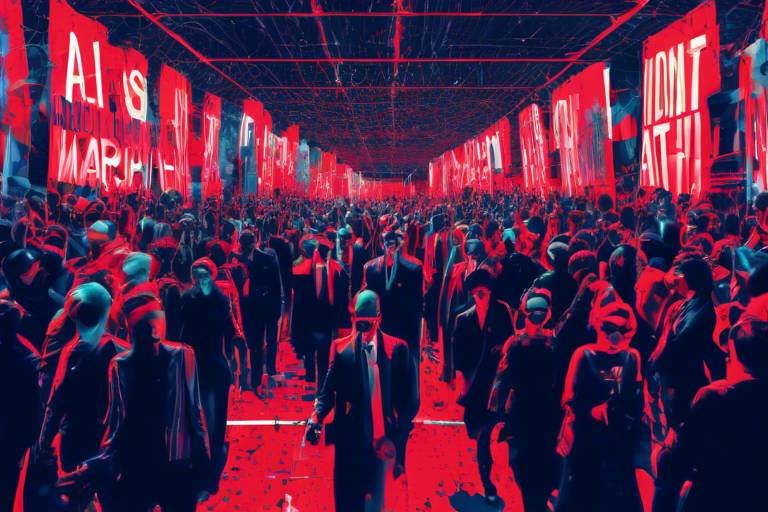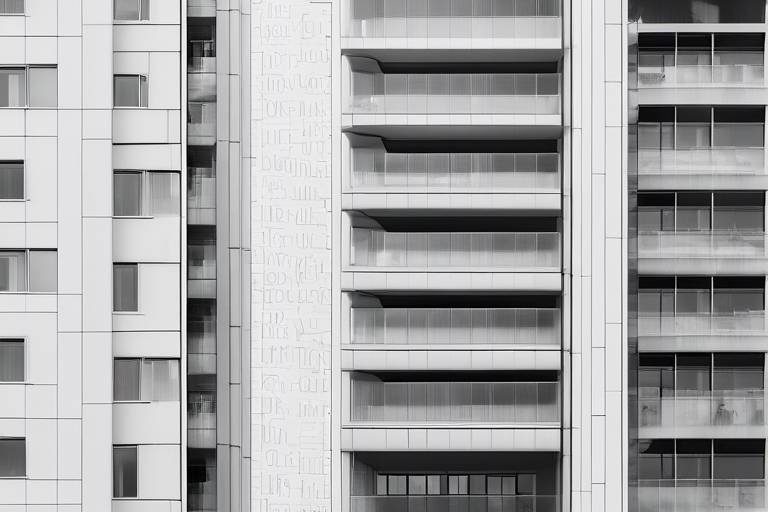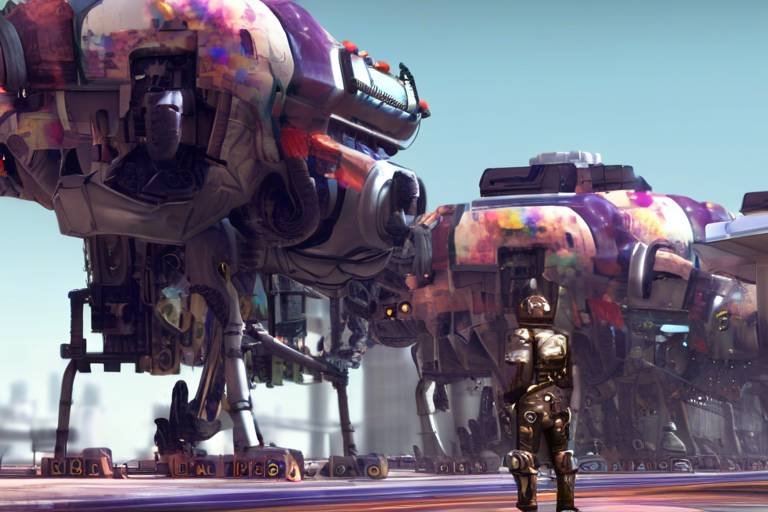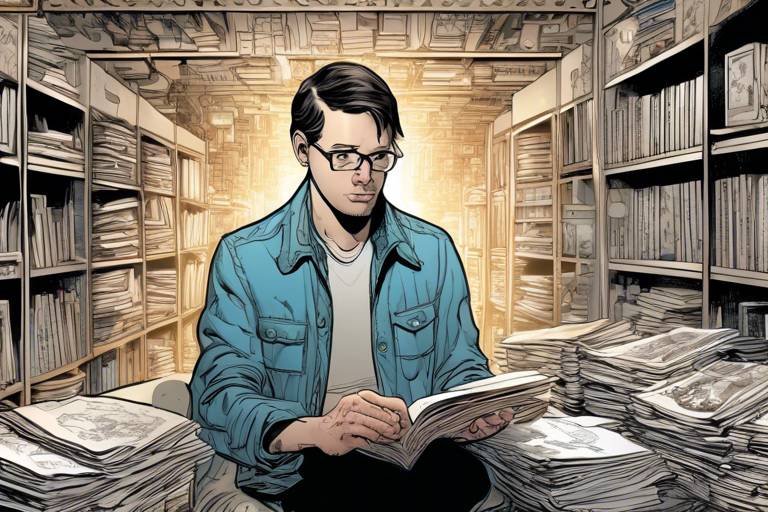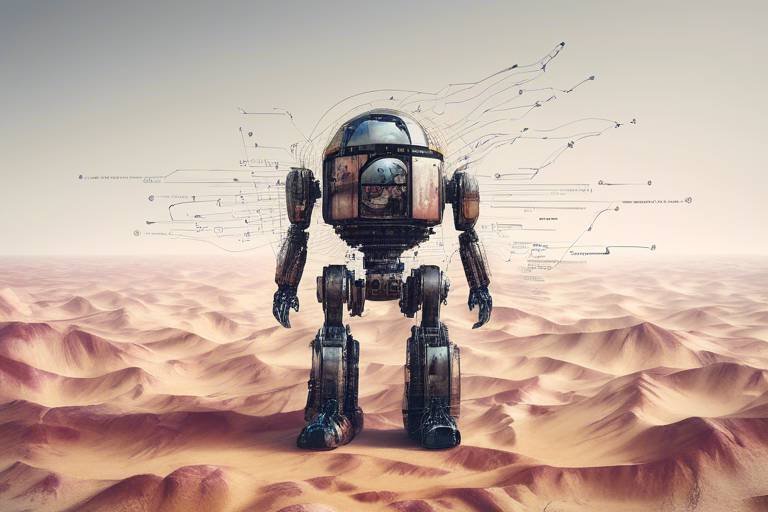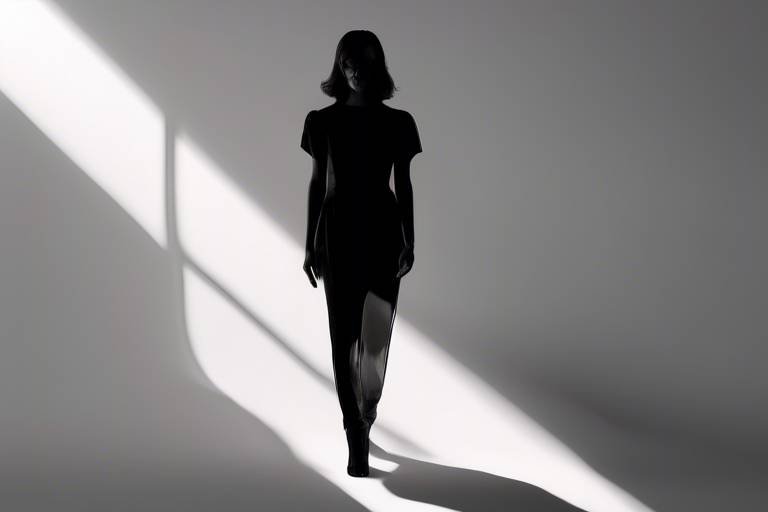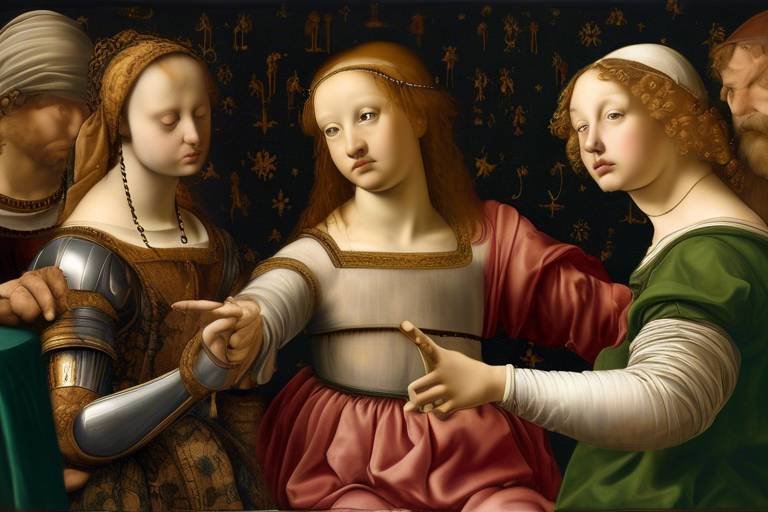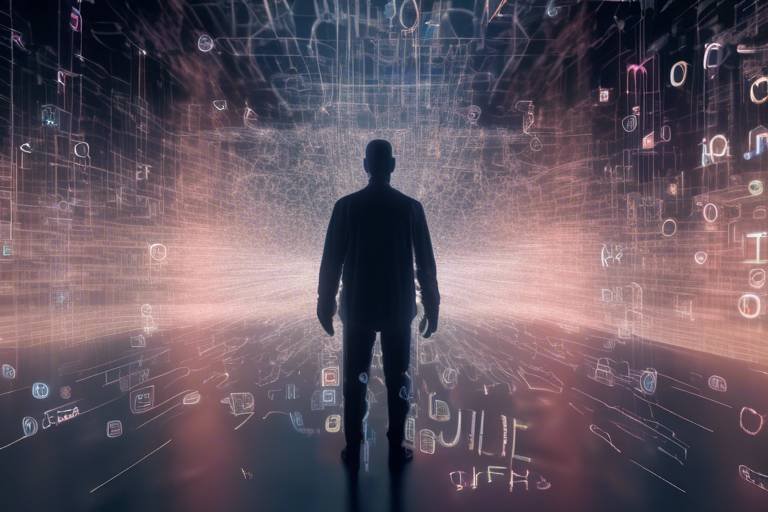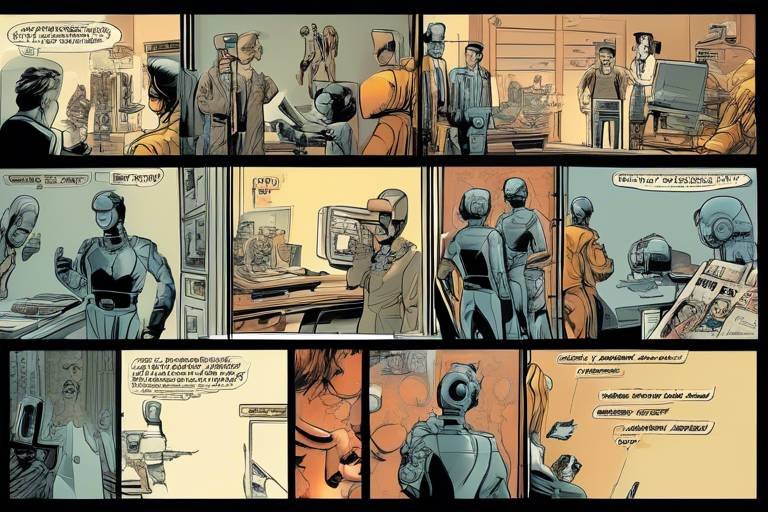AI's Role in the Evolution of Modern Art Techniques
In recent years, the world of art has witnessed a remarkable transformation, largely fueled by the advent of artificial intelligence. This fusion of technology and creativity is not just a passing trend; it is a fundamental shift that is reshaping the very fabric of artistic expression. Imagine a world where algorithms can not only analyze art but also create it, blurring the lines between human ingenuity and machine learning. As we delve deeper into this fascinating intersection, we will uncover how AI is not merely a tool but a collaborator, challenging traditional notions and inspiring artists to explore uncharted territories.
At the heart of this evolution lies the intersection of AI and art, where technology meets creativity in unexpected ways. Artists are increasingly collaborating with algorithms, utilizing AI to push the boundaries of their craft. This partnership opens up a treasure trove of possibilities, allowing for the exploration of new forms of expression that were previously unimaginable. For instance, artists can now create interactive installations that respond to viewer engagement, or generate visuals that evolve in real-time based on data inputs. The potential for innovation is limitless, and as we witness these collaborations unfold, it's clear that AI is becoming an integral player in the art world.
One of the most intriguing aspects of AI's role in art is its ability to generate original pieces of work. With the help of advanced algorithms, machines can analyze vast datasets of existing artworks to create something entirely new. This raises profound questions about authorship and artistic intent. Who is the true creator when a machine produces a piece of art? Is it the artist who programmed the AI, or the AI itself? These questions challenge our understanding of creativity and force us to reconsider the very essence of what it means to be an artist in the digital age.
Among the most exciting AI technologies in the art realm are Generative Adversarial Networks, or GANs. These sophisticated algorithms work by pitting two neural networks against each other: one generates images while the other evaluates them. This process mimics human creativity, resulting in unique artworks that often surprise even their creators. The aesthetic outcomes produced by GANs are not only visually stunning but also provoke thought and discussion about the nature of art itself.
To illustrate the impact of GANs, consider the following notable examples:
| Artwork | Artist/Creator | Year | Description |
|---|---|---|---|
| Edmond de Belamy | Obvious | 2018 | A portrait created using GAN technology, which sold at auction for $432,500. |
| AI Generated Nude Portrait #7 | Robbie Barrat | 2019 | A provocative piece that challenges traditional representations of the human form. |
Despite the exciting possibilities, GAN-generated art also raises significant challenges. Issues of originality and copyright come to the forefront. If an AI creates a piece of art, who owns the rights to it? Furthermore, what is the role of the artist in the creative process when machines are involved? These ethical dilemmas invite critical discussions about the future of art and the responsibilities of those who create it.
Beyond creation, AI is also revolutionizing the field of art curation. Algorithms are now being employed to analyze trends, identify emerging artists, and curate exhibitions. This not only enhances the accessibility of artworks but also enriches the discovery process for both artists and audiences. Imagine walking into a gallery where the exhibits adapt based on your preferences, creating a personalized experience that resonates with you on a deeper level.
As we look to the future, the impact of AI on artistic practices is poised to grow even more profound. With advancements in technology, we can anticipate more collaborative projects that meld human creativity with machine intelligence. Artists are beginning to embrace AI not as a replacement but as a powerful tool that can amplify their creative potential. This partnership could lead to groundbreaking works that redefine the boundaries of art.
Innovative projects are already showcasing the power of collaboration between artists and AI. For instance, some artists are using AI to generate initial concepts, which they then refine and interpret through their unique lens. This synergy results in artworks that are not only visually captivating but also deeply meaningful, reflecting the harmonious blend of human emotion and algorithmic precision.
Moreover, the integration of AI into art education is transforming how artists learn and create. By teaching upcoming artists to work with AI tools, educational institutions are expanding their creative horizons and redefining traditional art curricula. This approach encourages students to experiment with technology, fostering a new generation of artists who are comfortable navigating both the creative and technological landscapes.
- How is AI influencing contemporary art? AI is transforming contemporary art by enabling new forms of creativity, challenging traditional notions of authorship, and enhancing the curation process.
- What are GANs? Generative Adversarial Networks are algorithms that generate unique artworks by having two neural networks compete against each other.
- What are the ethical concerns surrounding AI-generated art? Ethical concerns include issues of originality, copyright, and the role of the artist in the creative process.
- Can AI replace human artists? AI is not intended to replace human artists; rather, it serves as a collaborative tool that can enhance creativity.

The Intersection of AI and Art
In recent years, the world of art has witnessed a fascinating transformation, driven by the rapid advancements in artificial intelligence (AI). No longer confined to the realm of science fiction, AI is now a tangible force reshaping how we create, perceive, and engage with art. Imagine a world where algorithms collaborate with artists, producing works that challenge our conventional understanding of creativity. This intersection of technology and artistry is not just a trend; it's a revolution that opens up new avenues for expression and innovation.
At its core, the fusion of AI and art is about collaboration. Artists are increasingly turning to AI as a partner in their creative processes. By leveraging machine learning algorithms, they can generate unique visual compositions, soundscapes, and even interactive installations that would have been unimaginable just a decade ago. For instance, artists like Refik Anadol have embraced AI to create immersive installations that transform data into stunning visual narratives. These projects not only showcase the capabilities of AI but also invite viewers to reconsider the very nature of artistic authorship.
Moreover, AI technologies are not merely tools; they are catalysts for new forms of expression. Artists can now explore the realms of generative art, where algorithms create visual works based on specific inputs and parameters set by the artist. This not only enhances creativity but also introduces an element of unpredictability. Think of it as a dance between the artist and the machine, where both contribute to the final outcome. The result? A rich tapestry of styles and themes that reflect the complexities of our digital age.
However, this intersection also raises important questions about the role of the artist. As AI systems generate artworks that are sometimes indistinguishable from those created by humans, we must ask ourselves: What does it mean to be an artist in this new landscape? Is the artist merely a curator of algorithms, or do they still hold the reins of creativity? This ongoing dialogue is essential as we navigate the evolving relationship between human ingenuity and machine intelligence.
To illustrate the potential of this collaboration, consider the following table that highlights some notable projects where AI has played a pivotal role:
| Project Name | Artist/Collaborator | Description |
|---|---|---|
| The Next Rembrandt | ING, TU Delft | An AI-generated painting mimicking the style of Rembrandt. |
| Edmond de Belamy | Obvious | A portrait created by GANs that sold at auction for $432,500. |
| Refik Anadol's Data Drift | Refik Anadol | Data visualization turned into an immersive digital experience. |
This table is just a glimpse into the myriad of ways AI is influencing art. As we move forward, it’s crucial to embrace this technology while also critically examining its implications. Are we ready to redefine our understanding of creativity and authorship? The answer lies in how we choose to engage with these emerging tools and the narratives we construct around them.
In conclusion, the intersection of AI and art is a dynamic space filled with potential and challenges. It invites artists to expand their horizons and rethink traditional boundaries, all while prompting society to ponder deeper questions about the essence of creativity. As we continue to explore this fascinating frontier, one thing is clear: the future of art is not just human; it's a collaboration between humanity and the extraordinary capabilities of artificial intelligence.

AI-Driven Creativity
In the realm of contemporary art, is not just a buzzword; it’s a revolution that challenges our very understanding of what it means to create. Imagine a world where machines can compose music, paint masterpieces, and even write poetry. Sounds like science fiction, right? Well, it’s happening now! The advent of artificial intelligence has opened the floodgates to a new frontier of creativity, one where algorithms and human imagination collide in spectacular ways.
At the heart of this transformation lies the question of authorship. When a machine generates a piece of art, who gets the credit? Is it the programmer who wrote the code, the artist who conceptualized the idea, or the machine itself? This conundrum is reshaping the art world, forcing us to reconsider the role of the artist in the creative process. Traditionally, artists have been seen as the sole creators of their work, but with AI stepping into the spotlight, we are witnessing a shift towards a more collaborative model.
AI systems, such as Generative Adversarial Networks (GANs), are at the forefront of this movement. These sophisticated algorithms are designed to learn from vast datasets, mimicking the creative processes of human artists. By analyzing patterns, styles, and techniques, GANs can produce original artworks that are often indistinguishable from those created by humans. The implications are profound: if a machine can create art that resonates with audiences, what does that mean for the future of artistic expression?
To illustrate the impact of AI on creativity, consider the following examples of how AI is being used to generate art:
- Music Composition: AI algorithms can compose symphonies that rival the works of classical composers, blending different genres and styles to create something entirely new.
- Visual Art: Artists are using AI to generate paintings, sculptures, and digital art, exploring themes that may not have been possible without machine assistance.
- Literature: AI can analyze literary styles and generate poetry or prose, pushing the boundaries of storytelling.
This new wave of AI-driven creativity raises essential questions about the nature of art itself. Is art defined by the hand that creates it, or is it the emotion it evokes in the viewer? As machines become more adept at producing art, we must grapple with the shifting definitions of creativity and originality.
Moreover, the integration of AI into the artistic process does not diminish the role of human artists; instead, it enhances their capabilities. Artists are beginning to embrace AI as a collaborative tool, using it to brainstorm ideas, explore new styles, and push the limits of their creativity. This partnership between human and machine is akin to having a creative assistant that can offer endless possibilities, allowing artists to focus on the conceptual aspects of their work while the AI handles the technical execution.
As we look ahead, the future of AI-driven creativity is brimming with potential. The fusion of human intuition and machine learning could lead to groundbreaking innovations in various art forms. However, it also necessitates a broader conversation about ethics, ownership, and the very essence of creativity. Are we ready to embrace a world where the lines between human and machine creativity blur?
| Question | Answer |
|---|---|
| Can AI truly create original art? | Yes, AI can generate original pieces by learning from existing artworks and creating new combinations, but the definition of originality is being re-evaluated. |
| Who owns the rights to AI-generated art? | This is a complex issue, as it involves the artist, the programmer, and potentially the AI itself. Current laws are still catching up to these advancements. |
| Is AI a threat to traditional artists? | Rather than a threat, AI can be seen as a tool that enhances creativity and opens new avenues for artistic expression. |

Generative Adversarial Networks (GANs)
Generative Adversarial Networks, or GANs, represent a groundbreaking leap in the intersection of technology and art. Imagine a scenario where two neural networks engage in a creative duel, pushing each other to produce increasingly sophisticated images. This fascinating concept is at the heart of GANs, which consist of two main components: the generator and the discriminator. The generator creates images, while the discriminator evaluates them, determining whether they are real or artificially generated. This dynamic interplay not only simulates human creativity but also produces stunning visual outcomes that challenge our understanding of authorship and artistic intent.
One of the most exciting aspects of GANs is their ability to learn from vast datasets. By analyzing thousands of images, these networks can identify patterns and styles, allowing them to generate unique artworks that echo the essence of the original content. This process can be likened to a chef experimenting with a diverse array of ingredients to create a dish that is both familiar and innovative. The result? Artworks that can range from hyper-realistic portraits to dreamlike landscapes, all crafted by the algorithms' interpretations of the data fed into them.
However, the implications of GANs extend beyond mere aesthetics. They raise profound questions about authorship and originality. When a machine creates a piece of art, who is the true artist? Is it the programmer who designed the algorithm, the dataset that informed it, or the machine itself? These questions challenge the very foundation of what it means to be an artist in the modern age. As we delve deeper into the world of GANs, it becomes essential to consider not just the art they produce but also the philosophical implications of machine-generated creativity.
In the realm of GAN art, we see a rich tapestry of styles and themes emerge. For instance, some artists are using GANs to create works that blend traditional techniques with digital innovation, leading to a new genre of art that fuses the old with the new. Others are exploring abstract concepts, using the technology to push the boundaries of visual expression. This evolving landscape is not just a testament to the capabilities of GANs but also a reflection of the artists' willingness to embrace technology as a means of expanding their creative horizons.
As we continue to explore the potential of GANs, it's crucial to acknowledge the challenges they pose. Issues surrounding copyright and the definition of originality are becoming increasingly pressing. When a GAN generates an artwork that closely resembles existing pieces, who holds the rights to that creation? These discussions are vital as they shape the future of not only AI-generated art but also the broader artistic community.
In conclusion, Generative Adversarial Networks are not just tools for creating art; they are catalysts for a new era of creativity that blurs the lines between human and machine. As artists and technologists continue to collaborate, we can expect to see even more innovative applications of GANs, pushing the boundaries of what art can be and how it can be defined.

Case Studies of GAN Art
Generative Adversarial Networks (GANs) have opened up a fascinating realm for artists, leading to the creation of unique pieces that challenge our understanding of creativity. One of the most striking examples is the work of Obvious, a Paris-based art collective. They gained worldwide attention when their GAN-generated artwork titled Edmond de Belamy was auctioned at Christie’s for a staggering $432,500. This portrait, which resembles a traditional oil painting, was generated using a dataset of portraits spanning six centuries. The collective's success not only highlights the potential of AI in art but also sparks discussions about the nature of authorship and the role of human creativity in the age of machines.
Another compelling case is the collaboration between artist Refik Anadol and AI technologies. Anadol uses GANs to create immersive installations that transform data into stunning visual experiences. His project, Archive Dreaming, takes a vast dataset of images and reinterprets them through the lens of AI, producing a constantly evolving digital artwork that captivates viewers. This work exemplifies how GANs can be used not just as tools for creating static images but as dynamic systems that engage the audience in a dialogue about perception and reality.
Moreover, the Artbreeder platform allows users to blend images using GAN technology, resulting in unique artworks that reflect the collaboration between human input and machine learning. Artists and non-artists alike can experiment with genetic algorithms to create portraits, landscapes, and abstract pieces. This democratization of art creation is a game-changer, as it empowers individuals to participate in the artistic process, blurring the lines between the artist and the audience.
In terms of commercial applications, brands are also leveraging GANs to create compelling marketing visuals. For instance, DeepArt allows users to transform photos into artworks in the style of famous painters. This application not only showcases the versatility of GANs but also raises questions about originality and the future of artistic expression. As these technologies become more accessible, the potential for new forms of art continues to expand.
The impact of GAN art extends beyond aesthetics; it invites us to reconsider the definitions of creativity and authorship. With each new project, we are reminded that art is not merely about the final product but also about the process and the dialogue it generates. As artists, technologists, and audiences engage with GANs, we are witnessing a profound shift in the art world—one that challenges our perceptions and pushes the boundaries of what art can be.
- What is GAN art? GAN art refers to artwork created using Generative Adversarial Networks, a type of machine learning model that generates new images based on training data.
- Who owns the rights to GAN-generated art? The ownership of GAN-generated art can be complex and varies by case, often depending on the input data and the artist's role in the creation process.
- Can AI replace human artists? While AI can generate art, it is generally viewed as a tool to enhance human creativity rather than a replacement for human artists.
- How can I create my own GAN art? There are various platforms like Artbreeder that allow users to experiment with GAN technology and create unique artworks without needing extensive technical knowledge.

Challenges of GAN Art
As we dive deeper into the realm of Generative Adversarial Networks (GANs) and their role in the creation of art, it becomes increasingly clear that while the technology offers exciting possibilities, it also presents a myriad of challenges. One of the most pressing issues is the question of originality. When an algorithm generates a piece of art, can we truly consider it original? After all, the AI is trained on existing artworks, learning from them and mimicking styles. This raises a fundamental question: is the artwork created by a GAN a unique expression, or is it merely a remix of human creativity? The line between inspiration and imitation blurs, creating a fascinating yet complex dilemma.
Moreover, the issue of copyright becomes a hot topic in discussions about GAN art. If an AI creates a piece that closely resembles the work of a well-known artist, who holds the rights to that piece? Is it the programmer who designed the algorithm, the dataset creators, or the AI itself? These questions are not just theoretical; they have real-world implications for artists, galleries, and collectors. The legal frameworks surrounding copyright are struggling to keep pace with technological advancements, leaving many in a state of uncertainty.
Another significant challenge lies in the role of the artist in the creative process. Traditionally, artists have been seen as the sole creators of their work, pouring personal experiences, emotions, and intentions into their art. However, with the rise of GANs, the definition of an artist's role is evolving. Are artists becoming mere curators of AI-generated content? Or are they still the driving force behind the creative vision? This shift in perception can be unsettling for many in the art community, as it challenges long-held beliefs about authorship and artistic intent.
In addition to these philosophical dilemmas, there are also technical challenges associated with GAN art. The technology is still in its relative infancy, and while it has made remarkable strides, there are limitations to what it can achieve. For instance, GANs can struggle with producing high-resolution images or maintaining coherence in complex scenes. Artists often find themselves needing to intervene in the process, tweaking parameters and guiding the AI to achieve the desired outcome. This raises yet another question: how much of the final piece is the result of human intervention versus machine learning?
Despite these challenges, the art world is buzzing with excitement about the potential of GANs. As artists and technologists continue to explore the intersection of creativity and AI, it’s clear that the conversation surrounding GAN art is just beginning. The challenges we face today may very well shape the future of art in ways we can only begin to imagine.
- What is GAN art? GAN art refers to artwork created using Generative Adversarial Networks, a type of AI that learns from existing artworks to generate new pieces.
- Who owns the copyright to AI-generated art? The ownership of copyright for AI-generated art is a complex issue, often debated among legal experts, artists, and technologists.
- Can GANs create truly original art? While GANs can produce unique pieces, they are trained on existing artworks, which raises questions about the originality of their creations.
- What role do artists play in GAN art? Artists often act as curators or guides in the creation of GAN art, influencing the output through their choices and interventions.

AI in Art Curation
As we dive deeper into the realm of art curation, it's impossible to ignore the transformative impact of artificial intelligence. AI is not just a tool; it's becoming a vital partner in the curation process, reshaping how we discover, analyze, and appreciate art. Imagine walking into a gallery where the artworks on display have been meticulously selected by an algorithm that understands your tastes better than you do! This is the future of art curation, where technology meets creativity to enhance our experience.
AI algorithms analyze vast amounts of data, including past exhibition trends, artist styles, and even audience reactions to different pieces. By harnessing this information, curators can create exhibitions that resonate more profoundly with viewers. For instance, AI can identify emerging artists whose work aligns with current cultural movements, ensuring that galleries remain relevant and engaging. This not only benefits the artists by providing them with exposure but also enriches the audience's experience by showcasing diverse and innovative works.
Moreover, AI's ability to process and analyze data at lightning speed allows for a more personalized art experience. Imagine an AI-driven app that curates a personalized gallery tour based on your preferences! Such technology can suggest artworks that align with your interests, making art more accessible and enjoyable. This kind of tailored experience can bridge the gap between traditional art forms and modern audiences, attracting a new generation of art lovers.
However, the integration of AI in art curation is not without its challenges. While it offers exciting possibilities, it also raises questions about the role of human curators. Are they becoming obsolete, or is AI simply a tool that enhances their capabilities? The best approach seems to be a collaborative one, where human intuition and creativity work hand-in-hand with AI's analytical prowess. This partnership can lead to exhibitions that are not only visually stunning but also intellectually stimulating.
In conclusion, the future of art curation is bright, with AI paving the way for innovative practices that enhance both the artist's and the viewer's experience. As we embrace this technology, we must also foster a dialogue about its implications, ensuring that the human touch remains at the heart of the artistic journey.
- How does AI influence the selection of artworks for exhibitions? AI analyzes trends and audience preferences to recommend artworks that resonate with viewers, ensuring a more engaging exhibition.
- Are human curators still necessary with AI in the picture? Yes! AI serves as a tool to enhance human creativity, not replace it. The best results come from collaboration between AI and human curators.
- Can AI help in discovering new artists? Absolutely! AI can identify emerging talents by analyzing various data points, bringing fresh perspectives to the art world.
- What are the ethical considerations of using AI in art curation? Ethical concerns include ensuring that AI does not perpetuate biases and that it supports rather than replaces human creativity.

The Future of AI in Art
The future of AI in art is not just a fleeting trend; it represents a profound shift in how we create, perceive, and understand artistic expression. Imagine walking through a gallery where every piece of art is not only a reflection of human creativity but also a collaboration with an intelligent machine. This is the reality that is fast approaching as artists and technologists come together to explore the uncharted territories of creativity. As we look ahead, we can anticipate a landscape rich with innovation, where the boundaries between human and machine-made art blur, creating a vibrant tapestry of new possibilities.
One exciting prospect is the emergence of collaborative art projects. These initiatives allow artists to harness the power of AI as a creative partner rather than viewing it as a competitor. For instance, artists are using AI algorithms to generate ideas, suggest color palettes, or even create entire compositions based on input parameters set by the artist. This collaboration fosters a unique dialogue where human intuition meets machine precision, resulting in artworks that challenge our traditional notions of authorship and creativity.
Furthermore, the integration of AI in art education is set to revolutionize the way we teach and learn about art. Imagine a classroom where students not only learn about classic techniques but also engage with AI tools that can help them visualize their ideas in real-time. This hands-on approach can expand their creative horizons and encourage them to experiment with styles and techniques that they may not have considered before. The ability to interact with AI as a learning tool opens up a new realm of artistic exploration, making the process more dynamic and inclusive.
As we delve deeper into the future, we must also consider the ethical implications of AI in art. Questions surrounding authorship, originality, and the role of the artist are more relevant than ever. Artists will have to navigate this complex landscape, finding ways to maintain their creative voice while embracing the capabilities of AI. This balancing act will likely lead to new definitions of what it means to be an artist in the age of technology.
In conclusion, the future of AI in art is poised to be a thrilling journey filled with opportunities for innovation and collaboration. The relationship between human artists and AI is evolving, and as we embrace these changes, we can expect to see a flourishing of creativity that challenges our perceptions and inspires new generations of artists. The canvas of the future is not just painted with colors but infused with algorithms, and it is up to us to explore this exciting new frontier.
- How is AI changing the way we perceive art?
AI is introducing new forms of expression and creativity, allowing for unique collaborations between machines and artists that challenge traditional artistic boundaries. - Can AI create original artwork?
Yes, AI can generate original pieces of art using algorithms, but the implications for authorship and artistic intent are still being debated. - What role will AI play in art education?
AI tools can enhance learning by providing students with innovative ways to visualize and experiment with their artistic ideas. - Are there ethical concerns with AI-generated art?
Yes, issues related to originality, copyright, and the role of the artist are significant topics of discussion in the context of AI in art.

Collaborative Art Projects
In the ever-evolving world of art, the emergence of that utilize artificial intelligence is nothing short of revolutionary. Imagine a canvas where human creativity meets the computational power of AI, creating a dialogue that transcends traditional artistic boundaries. This partnership not only redefines the creative process but also invites a broader audience to engage with art in ways previously unimagined. Artists are increasingly embracing AI as a collaborative tool, using it to enhance their creative expressions rather than viewing it as a competitor. This shift has opened up a realm of possibilities, sparking a new wave of innovation and experimentation.
One fascinating aspect of these collaborative projects is the ability of AI to analyze vast amounts of data, learning from existing artworks and styles. By doing so, it can suggest new ideas or even generate initial drafts that artists can then refine. This process can be likened to a conversation where the artist and AI exchange ideas, each influencing the other in a dance of creativity. For instance, a painter might start with a traditional landscape, and through interaction with an AI model, discover unexpected color palettes or compositions that breathe new life into their work.
Moreover, these collaborations often lead to unique exhibitions that challenge viewers' perceptions of authorship and creativity. Take, for example, the project “The Next Rembrandt,” where a team of data scientists and artists used algorithms to analyze Rembrandt's works and create a new painting in his style. This project not only showcased the potential of AI in art but also raised intriguing questions about originality and artistic intent. Who is the true artist—the human or the machine? Such inquiries are at the heart of contemporary discussions surrounding AI in art.
Additionally, collaborative projects often involve interdisciplinary teams that merge art with technology, science, and even philosophy. This convergence fosters a rich environment for innovation, where diverse perspectives contribute to the creative process. Artists, programmers, and researchers work hand-in-hand, pushing the boundaries of what art can be. These collaborations can take many forms, from interactive installations that respond to audience input to large-scale public art projects that incorporate community feedback and data.
As we look to the future, the potential for collaborative art projects is immense. With advancements in AI technologies, artists can explore new mediums and techniques that were once thought impossible. The line between human and machine creativity continues to blur, leading to works that are not only visually stunning but also conceptually rich. As artists and AI continue to collaborate, they will undoubtedly challenge our understanding of art and inspire future generations to think differently about creativity.
- What are collaborative art projects?
Collaborative art projects involve partnerships between artists and other entities, such as AI technologies, to create new forms of art that blend human creativity with machine learning capabilities. - How does AI influence artistic creativity?
AI can analyze existing artworks, suggest new ideas, and even generate drafts, allowing artists to explore innovative concepts and techniques. - Are AI-generated artworks considered original?
The originality of AI-generated artworks is a topic of debate, as it raises questions about authorship and the role of the artist in the creative process. - Can AI replace human artists?
While AI can assist in the creative process, it is generally viewed as a tool that enhances human creativity rather than a replacement for artists.

Education and AI in Art
The integration of artificial intelligence into art education is not just a trend; it's a revolution that is reshaping how artists learn and create. Imagine stepping into a classroom where traditional brushes and canvases are complemented by algorithms and data sets. This fusion of technology and creativity opens up a world of possibilities. With AI tools, students can explore new mediums and techniques that were previously unimaginable. For instance, AI can analyze an artist's style and suggest innovative variations, pushing the boundaries of their creative expression.
Furthermore, AI is democratizing art education. With online platforms and AI-driven tutorials, aspiring artists from all walks of life can access resources that were once limited to elite institutions. This accessibility fosters a diverse range of voices and perspectives in the art world, enriching the cultural tapestry. In a way, AI acts as a mentor, guiding students through complex concepts while providing instant feedback on their work. This immediate interaction can significantly enhance the learning experience, making it more engaging and effective.
However, it's essential to recognize that integrating AI into art education comes with its challenges. Educators must strike a balance between teaching traditional techniques and embracing new technologies. This requires a shift in curriculum design, where both aspects are valued equally. For instance, while students learn about color theory and composition, they should also be introduced to AI tools that can help them experiment with these concepts in real-time. The goal is not to replace the artist but to augment their capabilities, allowing them to explore their creativity in unprecedented ways.
To better understand the impact of AI in art education, consider the following table that outlines key benefits and challenges:
| Benefits | Challenges |
|---|---|
| Enhances creativity through technology | Need for updated curriculum |
| Increases accessibility to art resources | Potential over-reliance on technology |
| Provides instant feedback and guidance | Balancing traditional and modern techniques |
| Encourages collaboration between artists and AI | Understanding ethical implications |
As we look to the future, the role of AI in art education will undoubtedly grow. Institutions that embrace these changes will not only prepare students for the evolving art landscape but also inspire them to become pioneers of a new artistic movement. By equipping the next generation of artists with AI tools, we are setting the stage for a vibrant, innovative, and inclusive art world.
- How is AI used in art education? AI is used in art education to provide tools that help students explore new creative techniques, receive instant feedback, and analyze their work.
- Can AI replace traditional art skills? No, AI is meant to augment traditional skills, not replace them. It provides new avenues for creativity while still valuing foundational techniques.
- What are the challenges of integrating AI in art education? Challenges include the need for updated curricula, potential over-reliance on technology, and balancing traditional and modern artistic techniques.
- Is AI art considered real art? Yes, AI-generated art is considered real art, as it involves creativity and expression, albeit through a different medium.
Frequently Asked Questions
- How is AI influencing modern art techniques?
AI is revolutionizing modern art by introducing innovative techniques that blend technology with creativity. Artists are now collaborating with algorithms, leading to the emergence of new forms of expression that challenge traditional artistic boundaries.
- What are Generative Adversarial Networks (GANs)?
GANs are a type of AI that can generate unique artworks by simulating human creativity. They work by having two neural networks compete against each other, resulting in the creation of original pieces that reflect various styles and themes.
- Can AI-generated art be considered original?
This is a hot topic! While AI can create art that is visually stunning and unique, questions arise about authorship and originality. Is the artist the one who programmed the AI, or is it the AI itself? This gray area is constantly being debated in the art community.
- What are some ethical concerns surrounding AI in art?
Ethical concerns include issues of copyright, originality, and the role of the artist. As AI-generated art becomes more prevalent, questions about who owns the rights to these creations and how they fit into the traditional art world are increasingly important.
- How is AI used in art curation?
AI is reshaping art curation by analyzing trends and helping to curate exhibitions. This technology enhances the accessibility of artworks and allows for a more personalized experience for viewers, making art discovery easier than ever.
- What does the future hold for AI in art?
The future looks bright! As AI technology continues to evolve, we can expect more collaborative projects between human artists and AI. This could lead to exciting advancements in creativity and redefine the way art is taught and experienced.
- How can artists benefit from learning AI tools?
Learning to work with AI tools can significantly expand an artist's creative horizons. It allows them to explore new techniques, experiment with different styles, and even redefine traditional art curricula, making art education more relevant in today's tech-driven world.

